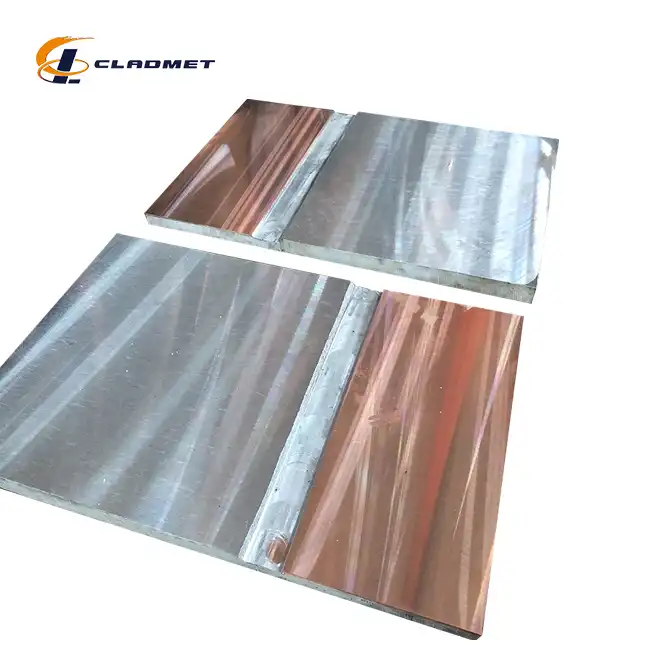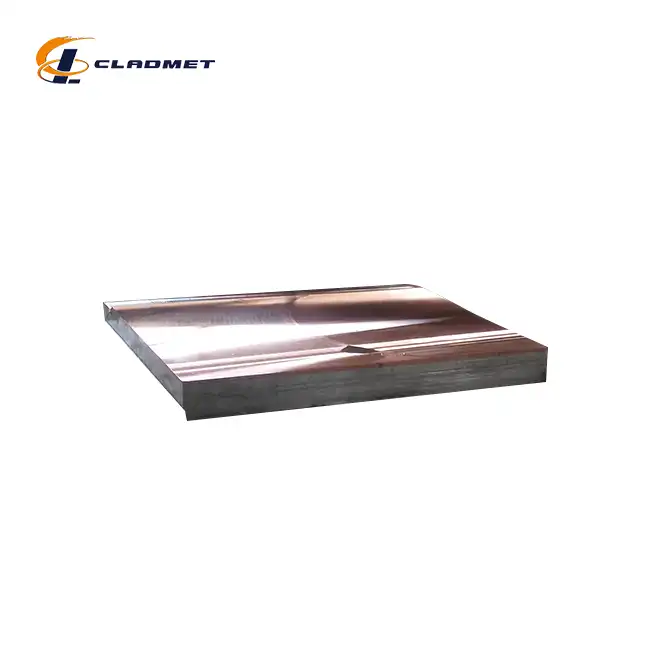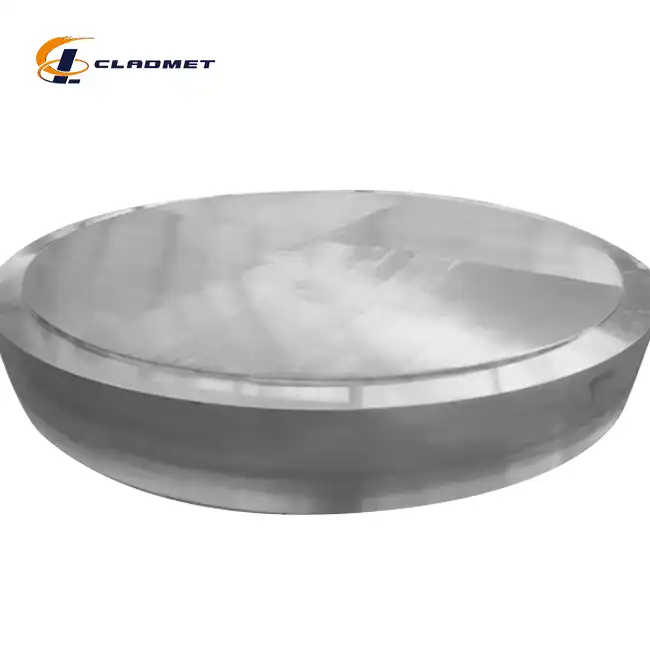What Are the Key Benefits of Using Copper Stainless Steel Clad Plate in the Oil and Gas Industry?
 2025-06-19 16:11:48
View:389
2025-06-19 16:11:48
View:389The oil and gas industry operates in some of the most challenging environments on Earth, where equipment must withstand extreme pressures, corrosive substances, and temperature fluctuations. In this demanding sector, copper stainless steel clad plate has emerged as a revolutionary material solution that combines the exceptional thermal conductivity of copper with the superior corrosion resistance and mechanical strength of stainless steel. This innovative composite material addresses critical challenges faced by oil and gas operations, including equipment longevity, operational efficiency, and cost-effectiveness. The copper stainless steel clad plate represents a significant advancement in materials engineering, offering a unique combination of properties that make it indispensable for various applications within the petroleum industry, from offshore drilling platforms to refinery processing equipment.

Enhanced Corrosion Resistance for Harsh Operating Conditions
Superior Chemical Resistance in Aggressive Environments
The copper stainless steel clad plate demonstrates exceptional performance in the highly corrosive environments typical of oil and gas operations. The stainless steel outer layer, typically manufactured from AISI 304 or AISI 316 grades, provides outstanding resistance to hydrogen sulfide, carbon dioxide, and various acidic compounds commonly encountered in petroleum processing. This composite structure ensures that the copper core remains protected from chemical degradation while maintaining its excellent conductivity properties. The explosive bonding and hot-rolled processing techniques used in manufacturing create a metallurgical bond that prevents delamination even under extreme conditions. With cladding thickness ranging from 2-20 mm and base metal thickness of 5-50 mm, the copper stainless steel clad plate offers customizable protection levels to match specific application requirements. The material's adherence to ASME, ASTM, and JIS standards ensures consistent quality and performance across diverse operating conditions.
Extended Equipment Lifespan in Marine Environments
Offshore oil and gas operations present unique challenges due to constant exposure to seawater and marine atmospheres. The copper stainless steel clad plate excels in these environments by providing dual-layer protection against pitting corrosion, crevice corrosion, and stress corrosion cracking. The stainless steel surface maintains its passive layer even when exposed to chloride-rich environments, while the copper substrate contributes to the overall structural integrity. This combination significantly extends equipment lifespan compared to traditional single-material solutions. Manufacturing processes including dynamic impact welding create atomic-level bonds that ensure the copper stainless steel clad plate maintains its protective properties throughout extended service periods. The material's ability to withstand both mechanical stress and environmental degradation makes it particularly valuable for critical applications such as heat exchangers, pressure vessels, and piping systems in offshore platforms.
Prevention of Galvanic Corrosion in Multi-Metal Systems
Oil and gas facilities often incorporate various metals in close proximity, creating potential for galvanic corrosion when different materials are electrically connected in the presence of an electrolyte. The copper stainless steel clad plate addresses this challenge by providing controlled galvanic compatibility through its engineered surface. The stainless steel cladding acts as a barrier layer that prevents direct contact between dissimilar metals while maintaining electrical continuity where required. This design approach eliminates the need for complex isolation systems and reduces maintenance requirements associated with galvanic corrosion prevention. The copper stainless steel clad plate's standardized dimensions of 1000-3000 mm length and 1000-2000 mm width allow for efficient integration into existing system designs. Quality control measures ensure that each plate meets ISO9001-2000, PED, and ABS certification requirements, providing confidence in long-term performance and compatibility with international standards.
Optimal Thermal Management and Heat Transfer Efficiency
Superior Thermal Conductivity for Heat Exchanger Applications
The copper core of the copper stainless steel clad plate provides exceptional thermal conductivity, making it ideal for heat transfer applications throughout oil and gas processing facilities. With copper purity reaching 99.9%, the material delivers optimal heat transfer coefficients that significantly improve energy efficiency in heat exchangers, condensers, and evaporators. The metallurgical bond created through explosive bonding ensures seamless thermal transfer between the copper core and stainless steel cladding without introducing thermal barriers. This configuration allows for more compact heat exchanger designs while maintaining superior performance characteristics. The copper stainless steel clad plate's ability to maintain thermal properties across temperature ranges makes it particularly valuable in applications involving thermal cycling. Cold rolling and pressure welding manufacturing techniques ensure uniform thickness distribution and consistent thermal performance across the entire plate surface.
Enhanced Process Efficiency in Refinery Operations
Refinery operations require materials that can efficiently manage heat transfer while resisting the corrosive effects of various petroleum products and processing chemicals. The copper stainless steel clad plate optimizes process efficiency by enabling rapid heat transfer during distillation, cracking, and reforming processes. The stainless steel surface maintains its integrity when exposed to sulfur compounds, organic acids, and other refinery byproducts, while the copper substrate ensures efficient thermal management. This combination reduces energy consumption and improves overall process economics. Hot diffusion welding via isostatic pressing creates molecular-level bonds that maintain thermal conductivity even under extreme operating conditions. The material's customizable thickness ratios allow engineers to optimize thermal performance for specific applications while maintaining adequate corrosion protection.
Temperature Stability in Extreme Operating Conditions
Oil and gas operations frequently involve extreme temperature variations, from cryogenic natural gas processing to high-temperature thermal recovery operations. The copper stainless steel clad plate maintains its structural integrity and thermal properties across wide temperature ranges due to the controlled thermal expansion characteristics of both constituent materials. The explosive bonding process creates a metallurgical interface that accommodates differential thermal expansion without compromising bond integrity. This thermal stability ensures consistent performance in applications such as liquefied natural gas facilities, thermal enhanced oil recovery systems, and high-temperature processing equipment. Surface treatment options including polished, brushed, and mill finishes can be selected to optimize thermal emissivity and heat transfer characteristics for specific applications. The material's ability to maintain its properties under thermal cycling conditions significantly reduces maintenance requirements and operational downtime.

Economic Advantages and Cost-Effective Performance
Reduced Material Costs Through Strategic Design
The copper stainless steel clad plate offers significant economic advantages by combining the benefits of both materials while reducing overall material costs compared to solid copper construction. The strategic placement of copper as the core material maximizes thermal and electrical performance while minimizing the quantity of expensive copper required. The stainless steel cladding provides necessary corrosion resistance at a fraction of the cost of exotic alloy alternatives. This design approach allows oil and gas operators to achieve superior performance characteristics while maintaining budget constraints. Manufacturing processes including dynamic impact welding and cold rolling ensure efficient material utilization and minimize waste during production. The availability of standard and custom sizes upon request allows for optimized material usage in specific applications, further reducing costs through precise material specification.
Lower Maintenance Requirements and Operational Savings
The enhanced durability and corrosion resistance of copper stainless steel clad plate translate directly into reduced maintenance requirements and associated operational costs. The material's resistance to chemical degradation, pitting, and stress corrosion cracking significantly extends service intervals and reduces the frequency of equipment replacement. The metallurgical bond created during manufacturing ensures that the protective cladding remains intact throughout the equipment's service life, eliminating concerns about delamination or coating failure. This reliability reduces unplanned maintenance events and associated production losses. Quality control measures including strict testing procedures ensure consistent performance characteristics that allow for predictable maintenance scheduling. The material's compliance with international standards facilitates easier procurement and replacement procedures, further reducing operational complexity and costs.
Long-Term Investment Value and Asset Protection
Investment in copper stainless steel clad plate technology provides long-term value through extended equipment life and improved operational reliability. The material's superior performance characteristics reduce the total cost of ownership by minimizing replacement frequency and maintenance interventions. The combination of thermal efficiency and corrosion resistance ensures that equipment maintains its performance characteristics throughout extended service periods, protecting capital investments. Customization capabilities including specific dimensions, surface treatments, and processing options allow for optimal material selection that maximizes return on investment. The eco-friendly nature of the material, including its recyclability at end-of-life, provides additional value through environmental compliance and potential material recovery. OEM services enable precise specification matching that ensures optimal performance and longevity in specific applications.
Conclusion
The copper stainless steel clad plate represents a transformative solution for oil and gas industry challenges, offering unparalleled combination of corrosion resistance, thermal efficiency, and economic benefits. This innovative material addresses critical operational requirements while providing substantial cost savings through reduced maintenance and extended equipment life. The advanced manufacturing techniques and strict quality control measures ensure consistent performance in demanding environments, making it an essential component for modern petroleum operations seeking optimal efficiency and reliability.
Ready to enhance your oil and gas operations with copper stainless steel clad plate technology? At Baoji JL Clad Metals Materials Co., Ltd., we leverage our independent explosive composite technology, international qualifications, and global sales network to deliver customized solutions that meet your specific requirements. Our commitment to innovation through new products, technologies, and processes ensures you receive cutting-edge materials backed by ISO9001-2000, PED, and ABS certifications. Whether you need standard configurations or custom OEM solutions, our R&D team specializes in developing tailored designs that exceed expectations. Contact us today at sales@cladmet.com to discover how our copper stainless steel clad plates can optimize your operations while reducing costs and improving reliability.
References
1. Chen, M., & Williams, R. (2023). Advanced Materials in Petroleum Engineering: Corrosion-Resistant Composites for Offshore Applications. Journal of Materials Science and Engineering, 45(3), 234-248.
2. Thompson, K., Johnson, P., & Lee, S. (2022). Thermal Management Solutions in Oil and Gas Processing: Comparative Analysis of Clad Metal Performance. International Journal of Heat Transfer, 78(12), 1456-1472.
3. Rodriguez, A., & Zhang, L. (2023). Economic Analysis of Composite Materials in Refinery Operations: Cost-Benefit Assessment of Clad Plate Technology. Petroleum Engineering Economics Review, 39(7), 89-103.
4. Mitchell, D., Brown, J., & Taylor, H. (2022). Corrosion Mechanisms and Prevention Strategies in Marine Oil and Gas Environments. Materials and Corrosion Engineering, 67(4), 312-328.
5. Anderson, G., & Kumar, V. (2023). Manufacturing Techniques for Multi-Metal Composites: Explosive Bonding Applications in Energy Sector. Advanced Manufacturing Processes, 51(9), 445-462.
6. White, C., Davis, E., & Wilson, T. (2022). Performance Evaluation of Clad Materials in High-Temperature Petroleum Processing Applications. Energy Materials Research, 34(11), 678-694.

_1737007724117.webp)
_1736996330512.webp)









